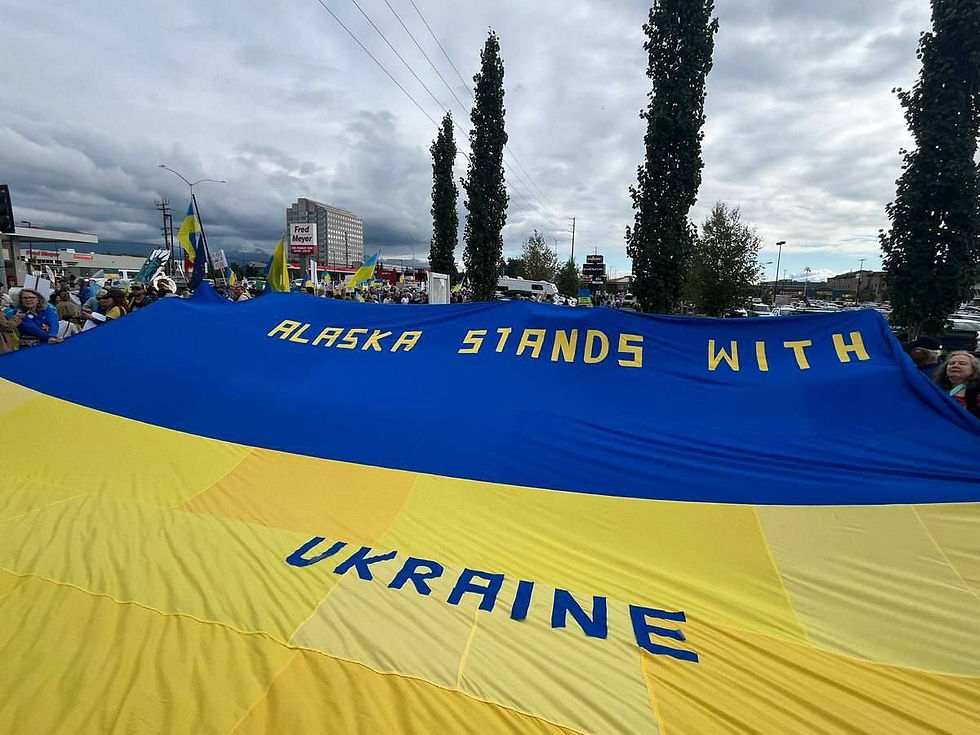Tensions, Theater, and Talks: Stage Set for High-Stakes Trump-Putin Summit in Alaska
- Olga Nesterova

- Aug 15
- 3 min read
The long-anticipated summit between President Donald Trump and Russian President Vladimir Putin is set to begin in Anchorage, Alaska. The high-stakes meeting—wrapped in spectacle, symbolism, and sharp geopolitical undertones—comes as both leaders prepare to discuss a ceasefire in Ukraine and broader U.S.-Russia relations.
The Russian delegation arrived ahead of schedule, making headlines from the moment they landed. Russian Foreign Minister Sergey Lavrov appeared in Anchorage wearing a USSR-emblazoned shirt (CCCP in Russian)—an unmistakable nod to Soviet nostalgia, and perhaps a hint at Russia’s plans for the future.

Meanwhile, Russian state media began rolling out its narrative, complaining of “spartan conditions” at their accommodations—a stadium temporarily converted for the occasion.
Head Russian propagandist Margarita Simonyan publicly complained that the Russian press corps was served Chicken Kyiv on their flight to the U.S. That alone, if true, carried symbolic weight — but it also raises a real question: Did U.S. taxpayers pay for the meals? And more broadly, are American resources being used to accommodate Russian state media during this summit — and if so, why?
In a more surreal turn, Russian state television released a propaganda video depicting a symbolic “love dance” between a U.S. and Russian couple, ending with the message: “Building future together.” The video quickly circulated online, drawing both amusement and criticism.
From Warsaw, Polish Prime Minister Donald Tusk weighed in on the summit with a pointed historical reference. “August 15 is a good day for talks with Russia about war and peace,” he posted. “On this day 105 years ago during the Battle of Warsaw Poles stopped the Red Army in its march on Europe. Luckily we didn’t know that Russia ‘is invincible’—and we beat them. Peace through strength, nothing else.”
Meanwhile, CNN reported on key figures joining President Trump in Alaska: Secretary Marco Rubio, Secretary Scott Bessent, Secretary Howard Lutnick, CIA Director John Ratcliffe, senior aide Susie Wiles, and real estate executive Steve Witkoff aka Trump’s Special Envoy, who has emerged as a central figure in backchannel diplomacy.
However, Trump's Ukraine envoy, retired General Keith Kellogg, will not attend the summit. According to CNN, Russian officials regard him as “too pro-Ukraine.”
Despite being labeled an international war criminal, Putin will receive a red carpet welcome and a personal greeting from Trump, NBC News reports. This was also confirmed by Kremlin’s spokesperson Peskov.
President Trump, speaking from Air Force One en route to Alaska, struck a familiar tone when addressing Putin's experience. “He’s a smart guy, been doing it for a long time, but so have I. I’ve been doing it for a long time. And here we are. We’re president.”
Lavrov previewed Russia's expectations ahead of the talks, emphasizing Moscow’s clear agenda: “We never make any assumptions in advance. We know we have an argument, we have a clear and well-defined position, and we will present it. A lot has already been done here during Witkoff’s visits. And Witkoff spoke on behalf of President Trump. I hope that we will continue this very useful conversation.”
Kirill Dmitriev, head of the Russian Direct Investment Fund, posted a photo with Witkoff online, stating: “We will continue our work with U.S. President Donald Trump’s special envoy Steven Witkoff and the American delegation led by President Trump in Alaska today.”

According to Kremlin spokesperson Dmitry Peskov, the summit program is scheduled to begin at 11 a.m. local time (3 p.m. ET / 12 p.m. PT) and will last six to seven hours. Putin, he said, is prepared to present documentation related to “Ukraine issue regulation,” bilateral triggers in U.S.-Russia relations, and potential economic projects.
From aboard Air Force One, Trump emphasized a desire for results: “I want certain things. I want to see a ceasefire. This is not to do with Europe. Europe’s not telling me what to do. But they’re going to be involved in the process, obviously, as will Zelenskyy, but I want to see a ceasefire rapidly. I don’t know if it’s going to be today, but I’m not going to be happy if it’s not today.”
Summing up the stakes, Trump said: “We’re going for a meeting with President Putin in Alaska, and I think it’s going to work out very well—and if it doesn’t, I’m going to head back home real fast.”
In a related development, the Élysée Palace confirmed Ukrainian President Volodymyr Zelenskyy will meet with French President Emmanuel Macron after the Alaska summit—an indication that Europe remains actively engaged despite Trump’s signals of unilateralism.
As the summit unfolds, certain things are already clear: an international war criminal is being welcomed on U.S. soil — once known as the land of the free and a beacon of democracy. Yet, throughout the day, significant protests and demonstrations by Alaskans in support of Ukraine have loudly expressed a very different sentiment.
When sentiment meets action, there is, indeed, hope.

















Comments